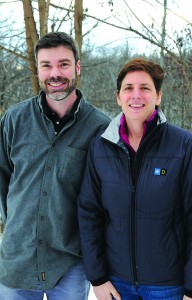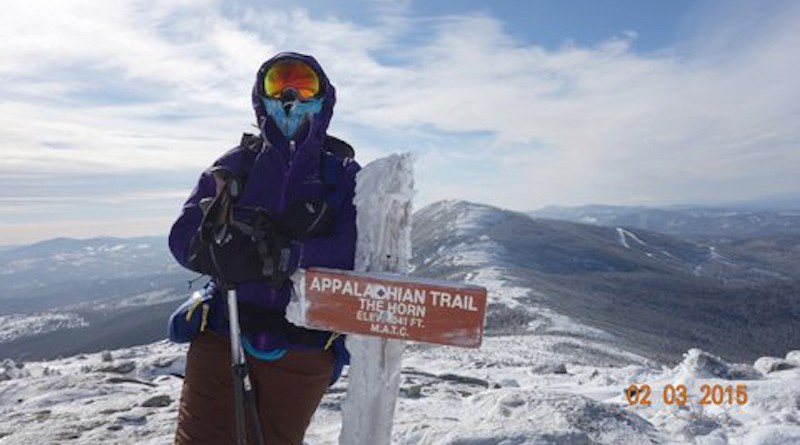115 Peaks—In Winter
BY JOHN FLOWERS
Nothing like spending a sunny afternoon hiking up a mountain. The picnic lunch tastes even better with a panoramic view.
But how about driving four hours to get to the base of a mountain for a hike of more than 4,000 feet to the summit, wading through armpit-high snowdrifts while braving sub-zero temperatures and fierce winds with only a frozen hard-boiled egg to gnaw on for sustenance? How about facing that kind of challenge 115 times on mountains throughout the Northeast — and only during the winter?
That’s a feat that Weybridge neighbors Michele Bayliss and Dean Ouellette completed in early 2016. They not only survived it, they thrived on the steady diet of climbing conquests known as the “Northeast 115.” With their ascent of Mount Abraham in Lincoln on the second-to-last weekend in January, the duo officially entered a very exclusive club of hiking enthusiasts who have successfully scaled the 115 peaks of 4,000 feet or higher in New England (67), the Adirondacks (46), and the Catskills (2).
“You almost feel like you’ve beaten winter,” Bayliss says philosophically of the accomplishment. “It’s kind of fun to test your limits.”
It was four years ago that Ouellette and Bayliss started their initial mega-hike: Climbing all 46 high peaks in the Adirondack Mountains during the course of three winters. As newly minted “Forty-Sixers,” they were eager to scale new heights en route to the Northeast 115 club.
They took the challenge very seriously, diligently checking weather forecasts prior to commencing their ascents in Vermont, Maine, New Hampshire and New York. They made sure to pack plenty of durable, weatherproof clothing and footwear, as well as water and food.
“When there were bad days, we stayed off those mountains,” Ouellette says.
Fortunately, Bayliss and Ouellette had the flexibility within their respective work schedules to make long-weekend trips, often scaling multiple peaks within a three-day period. Bayliss said she and Ouellette hiked a staggering 35 peaks last winter, which required outings virtually every weekend. And last winter, lest we forget, was a particularly brutal one in both temperature and precipitation.
“There were days when I would ask myself, ‘Why am I doing this?’” Bayliss concedes. But she invariably shook off that feeling at around the three-hour mark of each climb, the point at which she hits her stride.
Ouellette has always been an avid outdoorsman and loves to test his endurance. But there were a few times when he, too, thought about abandoning a hike when the going got extremely tough. It never came to that, however.
“We never turned away from a hike,” Ouellette says. “We kept persevering. We remained focused on that goal. The conditions would dictate what we would do.”
Some of the ascents were, for them, a piece of cake. Comfortable temperatures, little wind, a shallow blanket of snow and, of course, no pesky bugs. Those easy jaunts stood in sharp contrast to others. The pair recalled some steep vertical climbs through snow so deep they had to tunnel through it. Then there was the day when, at around 100 yards from one of the mountain summits, 100-mph winds blew both climbers over multiple times. There were times they lost feeling in their fingers. Ouellette suffered some frostbite on a small part of his face that was not covered by clothing or goggles.
Bayliss said the Maine summits offered her a particularly big challenge. She specifically recalls their ascent of Mount Redington during a nasty cold snap.
“No one had been there for weeks,” she says, noting she and Ouellette had to do most of the trail breaking themselves. She recalled falling into a snow-covered stream, crawling up a frozen riverbank and being poked by a lot of branches.
Then there were the diabolical “spruce traps.” These occur when snowfall envelopes a spruce tree, but leaves an air pocket under the tree’s limbs. So hikers can unwittingly step into such a pocket and suddenly sink down, requiring a lot of effort at times to free oneself.
“It’s very tiring,” Bayliss says of the battles and spruce traps and other natural pitfalls.
Neither got overconfident after completing a harsh segment of trail.
“You realize that nature could kick your ass next week,” Bayliss says.
Ouellette and Bayliss were careful to pack adequate provisions and life saving equipment. They also brought along maps of the terrain they were covering, which at times proved a mixed blessing. For example, one map indicated they could shave a mile off one of their treks by making a detour through a snow-filled slope. That slope proved to be wildly vertical, with deep snow cover leading to bad footing. Worse still, there were no exposed tree branches or rocks to grab to avoid the inevitable backslides. The shortcut ended up adding a lot of extra time to their climb.
‘SMELLS LIKE HARD WORK’
 Both agree that the Tripyramid peaks in New Hampshire were also a long slog. They noted an especially grueling vertical climb of six-tenths of a mile that took three hours.
Both agree that the Tripyramid peaks in New Hampshire were also a long slog. They noted an especially grueling vertical climb of six-tenths of a mile that took three hours.
“There were no hand-holds,” Bayliss says. “We got to the top and it was freezing. It was traumatic.”
Some of their hikes lasted around half a day. Others involved 14.5-hours of at-times bone chilling agony.
But they regret none of it, and made some good friends along the way with other hard-core hikers.
“There is a smaller (hiking) community during the winter,” Ouellette says. “It was a great way to meet like-minded people.”
The evidence of their efforts could be measured in their perspiration-saturated clothing at the end of the day.
“It was like a locker-room smell,” Bayliss says with a chuckle. “You would never say, ‘It stinks.’ You would say, ‘It smells like hard work.’”
Ouellette and Bayliss have submitted their names for official recognition of their completion of the winter Northeast 115. The current list bears the names of only 81 climbers, only 12 of whom hail from Vermont. Fewer than 20 on the list are women.
While one would think Bayliss and Ouellette have earned a rest after the Northeast 115, they have no plans to retire their hiking boots.
Bayliss wants to do more hiking in the Adirondacks, while Ouellette has set his sights on completing “The Grid.” That involves hiking all 48 of New Hampshire’s 4,000-foot mountains every month during a calendar year. Yes, that’s a total of 576 peaks in 12 months. Some of those who have completed The Grid jokingly refer to themselves as “Gridiots.”
“I don’t mind pushing my body to a certain point to see what I can do,” Ouellette says.
By John Flowers. Originally published in the Addison Independent


